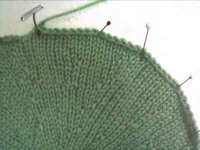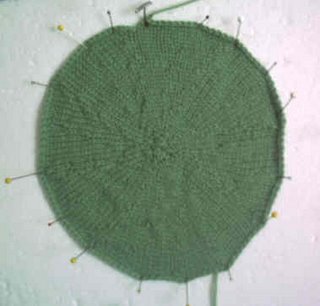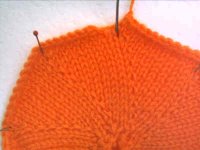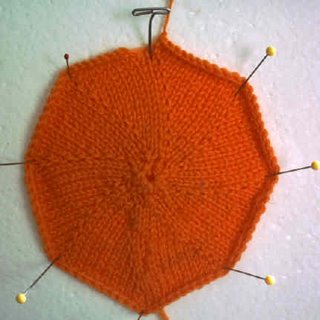Circles Round IV -- Detour to the Disc
 The Disc Circular Medallion hides its increases by distributing them evenly throughout the round (so use some form of closed increase such as a M1 or a bar (k f&B) increase if you don't want to thwart its goals). If the twisted stitch that can result from a bar increase bothers you, knit into the back on that stitch on the next round to untwist the stitch.
The Disc Circular Medallion hides its increases by distributing them evenly throughout the round (so use some form of closed increase such as a M1 or a bar (k f&B) increase if you don't want to thwart its goals). If the twisted stitch that can result from a bar increase bothers you, knit into the back on that stitch on the next round to untwist the stitch.Cast on 8 stitches, divide evenly onto four needles, join, do not twist, knit with a fifth needle.
Place markers after every 2 stitches.
Round 1: knit
Round 2: increase into every stitch (16 total -- 4 per needle)
Round 3 & all odd Rounds: Knit
Round 4: (K1, increase 1)8x (24 total - 6 per needle) if M1 is used this is (K1, M1, K1)8x if bar increase, (K1, increase into next stitch)8x
Round 6: (K2, increase 1)8x (32 total - 8 per needle)
Round 8: (K3, increase 1)8x (40 total - 10 per needle)
Round 10: (K2, increase 1, K3, increase 1, k3)4x (48 total - 12 per needle)
Round 12: (K1, increase 1, K5, increase 1, k4)4x (56 total - 14 per needle)
Round 14: (K5, increase 1, K6, increase 1, k1)4x (64 total - 16 per needle)
Round 16: (K2, increase 1, K7, increase 1, k5))4x (72 total - 18 per needle)
Round 18: (K1, increase 1, K8, increase 1, k7))4x (80 total - 20 per needle)
Round 20: (K6, increase 1, K9, increase 1, k3))4x (88 total - 22 per needle)
Round 22: (K2, increase 1, K10, increase 1, k8))4x (96 total - 24 per needle)
Round 24: (K1, increase 1, K11, increase 1, k10))4x (104 total - 26 per needle)
Round 26: (K7, increase 1, K12, increase 1, k5))4x (112 total -- 28 per needle)
Round 28: (K2, increase 1, K13, increase 1, k11))4x (120 total -- 30 per needle)
Round 30: (K1, increase 1, K14, increase 1, k13))4x (128 total -- 32 per needle)
Continue as established, knitting one round plain between increase rounds and moving the increases as shown.
 The "as established" instruction can trip you up a bit. The obvious pattern in rounds 4, 6 & 8 is to knit one additional stitch before increasing but that's not the pattern/progression that matters. The hidden pattern is that in each round the increases are evenly distributed with each increase occurring at the total number of stitches divided by 8. By happy coincidence this also ends up being half the round number.
The "as established" instruction can trip you up a bit. The obvious pattern in rounds 4, 6 & 8 is to knit one additional stitch before increasing but that's not the pattern/progression that matters. The hidden pattern is that in each round the increases are evenly distributed with each increase occurring at the total number of stitches divided by 8. By happy coincidence this also ends up being half the round number.The number of stitches you have between each increase is as follows:
- Round 4: 2
- Round 6: 3
- Round 8: 4
- Round 10: 5
- Round 12: 6
If I'm not careful, I misinterpret this instruction, continue the progression of knitting one additional stitch before increasing used in rounds 4, 6, & 8 and end up knitting a cross between a swirl octagon and this "circle" -- yielding a good but unintended result. So my orange Baby Ull example continued as follows:
 Round 10: (K4, increase 1)4x (48 total - 12 per needle)
Round 10: (K4, increase 1)4x (48 total - 12 per needle)Round 12: (K5, increase 1)4x (56 total - 14 per needle)
Round 14: (K6, increase 1)4x (64 total - 16 per needle)
Round 16: (K7, increase 1)4x (72 total - 18 per needle)
Round 18: (K8, increase 1)4x (80 total - 20 per needle)
Not too surprisingly, what I ended up with is a swirl octagon that does a very convincing imitation of a circle. This swirl octagon spirals in the opposite direction of the original.
The oops example was knit in orange Baby Ull using 2.75mm needles. I used the bar (knit into front and back) for the first round of increases and a M1 method for all others. It was knit out to 80 stitches (20 per needle). This is oops is the method I used to create the tams/berets shown here.



0 Comments:
Post a Comment
Subscribe to Post Comments [Atom]
<< Home